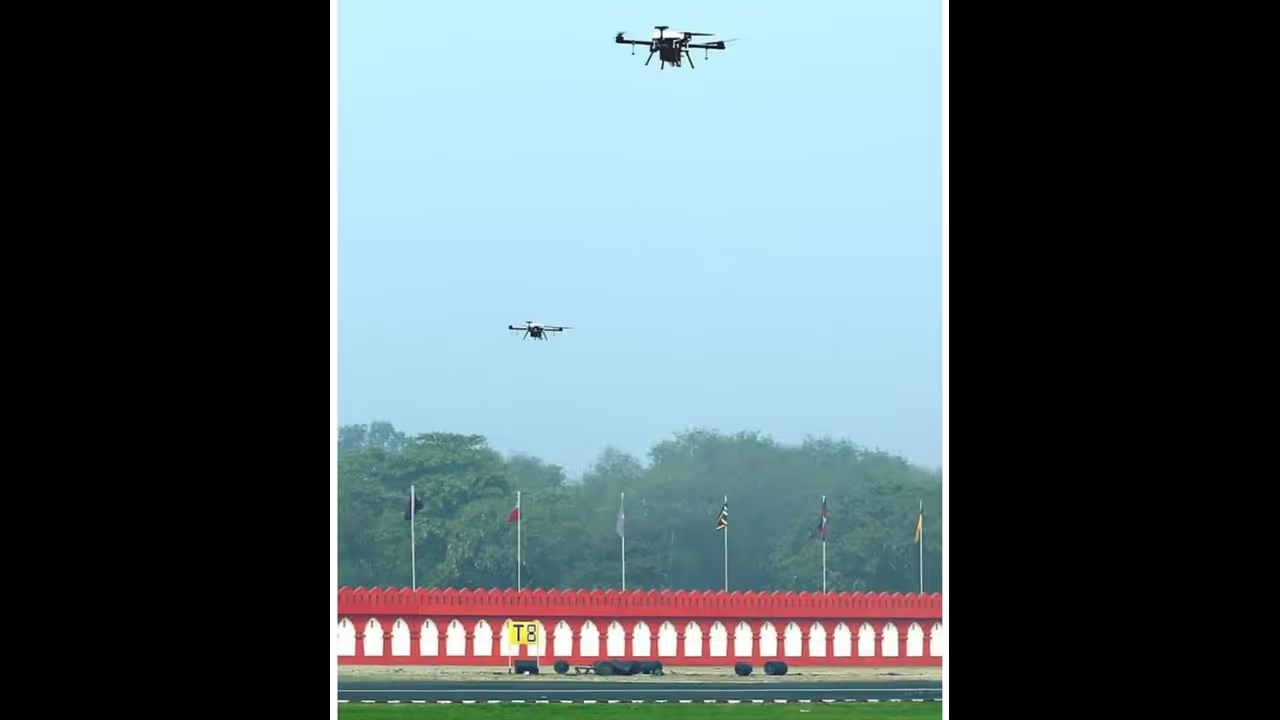The devices used at Jammu were probably crude technology demonstrators but they put all military and other sensitive deployments on notice, says Lt Gen Syed Ata Hasnain.
It needs no research to write about the long-expected arrival of the phenomenon of delivery of explosive material on targets by small drones. The Jammu-based Indian Air Force facility at the airport technical area was subjected to a drone-based IED attack in the early hours of Sunday, causing minor damage and an odd non-serious casualty (as reported).

For a couple of years now, quadcopters (rotary-wing drones) of varying sizes have been crossing the LoC and the international border (IB) from Pakistan and PoK (Pakistan-Occupied Kashmir) into Punjab and J&K in an effort to exploit an emerging technology for effective use in hybrid warfare. It had started some years ago mainly in J&K, to photograph and map possible locations of manned positions on the Indian side, to facilitate infiltration.
For the last five years or a little more, the focus shifted to terror groups attempting to use these airborne vehicles to transport a limited amount of warlike stores to the areas slightly in depth of the defensive canals in Punjab. With the counter-infiltration posture becoming far more effective, the supply chain of these stores had been disrupted causing a negative turn in terrorist capability.
The experience of terrorists and their sponsors in logistic supply by drones did not really overcome the challenge but a possible indulgence in explosive payloads using these was expected sooner than later.
The employment of small-size unarmed drones capable of delivering a payload of explosives up to a standoff distance is actually the terrorists' dream. Ideally, they would like to indulge in heavier drones for greater terminal effect but for a beginning, this would be considered suitable in changing the complexity and direction of hybrid war.
It is the message of capability that is important because that puts the regular forces on alert with an out of proportion quantum of effort, energy and deployment, all of which are resource sapping. Neutralizing small size drones is difficult due to the limited time they are likely to be in the air.
If launched over short distances from just across the border or LoC their low flight path and a short time to target precludes any manual acquisition of targets, especially at night.
More important for us is the countermeasures that we propose. Passive defence is fine and will have to be resorted to through more air sentries and quick reaction teams (QRTs) trained to fire in a virtual air defence role. Hybrid wars in the subcontinent need not be fought only on the basis of absorbing Pakistan’s deceitful cooperation with terrorist elements.
Rotary or fixed-wing drones do not require very high technology. But before these become a nuisance for us and a source of unnecessary embarrassment the right offensive options must be clearly thought through. It is not long before a few such drones will be launched to target our ammunition dumps, from within the precincts of the LoC or just outside it.
The devices used at Jammu were probably crude technology demonstrators but they put all military and other sensitive deployments on notice, requiring round-the-clock surveillance (more of the manual kind) to prevent a repeat.
Given the fact that these devices can be GPS-enabled and locations of important installations can all be surveyed by satellite, the accuracy with which targeting can be executed cannot be underestimated. The sensitive border region of North Punjab and Jammu has a plethora of such targets in the vicinity of the IB.
The advantage which the terrorists enjoy of physically infiltrating and striking in a single night can also be applied using such drones. They can in fact be used to strike at multiple objectives on a broad front, divert attention and then use physical infiltration to exploit the resultant chaos.
It may be recalled that on September 14, 2019, Yemen's Houthi rebels attacked an Aramco oil refinery in Saudi Arabia’s capital city, Riyadh. They used six bomb-laden drones along with 11 missiles to paralyze the working of the refinery. This is not something difficult to replicate in our context where oil installations at Jammu or Pathankot and various communication centres at a depth of no more than 10-20 km remain vulnerable.
The incident we have witnessed saw only two drones in use but the entire phenomenon of drone swarms is not something unknown to us; it is a methodology that could eventually be the adopted tactics. Swarms may offer large targets but carry a higher surety of some of the payloads reaching the target even if a few get shot down.
Lt Gen Syed Ata Hasnain is former GOC of the Srinagar-based 15 Corps and Chancellor Central University of Kashmir
